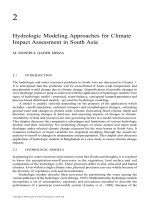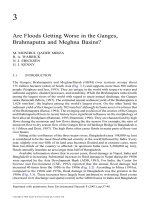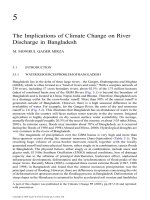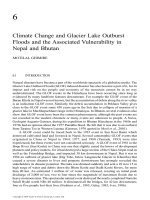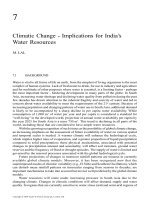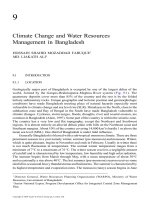Bài giảng climate change and biodiversity
Bạn đang xem bản rút gọn của tài liệu. Xem và tải ngay bản đầy đủ của tài liệu tại đây (1.89 MB, 38 trang )
Impacts of Climate
Change on
Biodiversity
We are altering the system
Variations of the Earth‟s surface temperature
over the past 1,000 years
(IPCC, 2001)
14.5
Observed changes
14.0
13.5
1850
1900
1950
Year
AOGCM predictions
Global surface warming (ºC)
Temperature (ºC)
IPCC Fourth Assessment Report (2007)
2000
4
A2
3
A1B
2
B1
1
com
0
-1
1900
2000
Year
2100
Potential pathways of biodiversity impacts from climate change
Effects on
distributions
Effects on
abundance
Effects on
phenology
Evolutionary
adaptation
Effects on
physiology
Changes to
species interactions
Further effects on
distributions and
abundance
Extinction of
some
species
Changes in
ecological
communities
(adapted from Hughes 2000, TREE)
(Foden et al., 2008)
Relative effect of major drivers of changes on biodiversity
(Sala et al. 2000, Science)
Is a climate change signal already apparent?
Phenological changes:
E.g. UK birds are
laying eggs earlier
(Crick et al. 1997, Nature)
a, corn bunting; b, chiffchaff; c, magpie
Bird phenology and asynchrony with
food supply:
Geese not able to acquire adequate body
stores quickly enough to breed before the
quality of food for their young decreased.
Van Der Jeugd et al. 2009
Bird phenology and asynchrony with
food supply:
Pied flycatcher
www.luontoportti.com
www.progressive-charlestown.com
Winter moth caterpillar
Populations of pied flycatchers in some areas in
Europe declined up to 90% because chicks did not
have enough food.
Visser et al. (2006)
Is a climate change signal already apparent?
Abundance changes:
E.g. Increasing shrub
abundance in the
Arctic
(Sturm et al. 2001, Nature)
Is a climate change signal already apparent?
E.g. Twentieth-century
changes in the
distribution of the
Speckled Wood
Butterfly (Pararge
aegeria)
(Parmesan et al. 1999, Nature)
Pole-ward distribution shifts:
1970 - 1997
1940 - 1969
1915 - 1939
Observed Ecological Impacts Range shifts
Mammals
Red fox
has expanded into the North
Arctic fox
has contracted to Atlantic
Unable to move
Quiver trees are
distributed in South
Africa. This species
can retain water in
its leaves and stems,
and lives more than
200 years. Over the
last decades, more
than 70%
populations of this
species has
disappeared.
Foden et al. (2007)
Quiver tree in Namibia
Is a climate change signal already apparent?
Upslope distribution shifts: an example from Madagascar…
Species
endemic to the
Tsaratanana
Massif, and their
associated
habitats
Platypelis alticola
Grass wetland & forest margin at 2500m
Calumma tsaratananensis
Forest at 2600m
Phelsuma lineata
Rocky outcrops and heathland at 2750m
NASA
MODIS
(Raxworthy et al. 2008 Global Change Biology)
Elevational
displacement of
distribution midpoint
between 1993 and
2003 for 30 species of
reptiles and
amphibians surveyed
at Tsaratanana
(Raxworthy et al. 2008 Global Change Biology)
Mean displacement = 65m upslope
(p<0.01)
Is a climate change signal already apparent?
Extinction:
E.g. widespread amphibian extinction
in Central and South America
(~30 species of harlequin frogs feared
extinct)
1. Lifting-cloud-base hypothesis
(Pounds et al. Nature 1999)
2. Climate-linked-epidemic hypothesis
(Pounds et al. Nature 2006)
3. Climate-driven reductions in the
quantity of standing leaf-litter
(Whitfield et al. PNAS 2007)
C.H. Smith, US Fish and Wildlife Service
The extinct golden toad (Bufo periglenes)
Pest species and disease are also moving
polewards and upward
Eg Chytrid fungus
Cooler days and warmer nights have resulted in
favorable conditions at mid-elevation sites
Changes in dynamics of the skin fungus is
implicated in subsequent extinctions of 74
harlequin frog species.
Is a climate change signal already apparent?
“This suite of analyses generates „very high confidence‟
(as laid down by the IPCC) that climate change is
already affecting living systems”
(Parmesan and Yohe 2003, Nature)
“the balance of evidence from these studies strongly
suggests that a significant impact of global warming is
already discernible in animal and plant populations”
(Root et al. 2003, Nature)
What might the future hold?
Predicting distribution shifts using niche-based species distribution
models
Modeling
algorithm (e.g.
Maxent, GARP)
present day
future
(Pearson & Dawson 2003 Global Ecology and Biogeography)
Predicted distribution shifts under climate change
Upslope range contraction
Present day
2050s projection
Pole-ward range expansion
Present day
2050s projection
„Bioclimate envelope‟ predictions for Twinflower (left) and White-beaked
sedge (right)
(Pearson et al. 2002 Ecological Modelling)
Extinction risk from climate change
S = cAz
(Thomas et al. 2004, Nature)
“we predict, on the basis of midrange climate-warming scenarios for
2050, that 15-37% of species in our
sample of regions and taxa will be
„committed to extinction‟”
Dispersal ability – will species be able to „keep up‟
with changing climate?
future
current
Thomas et al (2004, Nature):
species-level extinction
estimated to be 21-32% with
universal dispersal, and 38-52%
with no dispersal (under
maximum projected climate
change)
But… what can we predict with confidence?
• We have a fair idea of general patterns
and trends that can be expected over the
next century, including:
– upslope and poleward distribution shifts
– changes in phenology and abundance
– extinction
• However, the magnitude of future impacts
of climate change on biodiversity remains
difficult to predict.
Vulnerable species
• Specialized habitat and/or microhabitat requirements
• Narrow environmental tolerances or thresholds that are
likely to be exceeded due to climate change at any stage
of life cycle
• Dependence on specific environmental triggers or cues
that are likely to be disrupted by climate change
• Dependence on interspecific interactions which are likely
to be disrupted by climate change
• Poor ability or limited opportunity to disperse to or colonize
a new or more suitable range



